|
|
|
|
|
History |
|
|
|
|
|
|
|
|
|
|
|
|
|
|
|
|
|
Subsidiaries: |
|
|
|
|
|
|
|
|
|
|
|
|
|
|
|
RR Memorabilia: |
|
|
|
|
|
|
|
|
|
|
|
|
|
|
|
|
|
Utilities: |
|
|
|
|
E-mail

|
|
|
History and Background |
|
THE
NORMANED RAILROAD
traces its origin from 1965
when it began as a commuter-freight mixed shortline with one restored
locomotive of uncertain heritage and six or seven various pieces of rolling
stock servicing a model raceways layout in the basement of our Milford,
Connecticut home. |
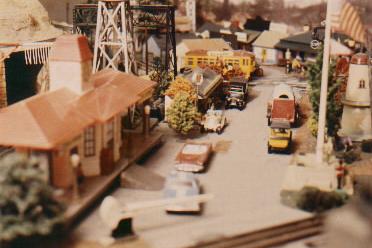
|
Traffic is brisk past the Noma Town Station (at left), to and from the
tourist trolley stop at neighboring Central City in the distance,
where a yellow trolley car is just about ready to start another round
trip up and down Tunnel Mountain. A branchline connecting track is
visible in the foreground. |
|
|
The NORMANED
is named after its co-founders, Norman and Ned Wright, the model railroad's
name being an obvious overlapping combination of their two first names. A
totally-owned subsidiary company, the “Tiny Transportation Company,” is
named after the wife and mother of the founders, whose nickname in her Ohio
hometown was “Tiny.” The TTCo., which was in charge of the raceways
operation in Connecticut, now is represented on the NORMANED
by the following: |
- a static display of a trolley museum
- an operating trolley line which transports workers and tourists
to and from a coal mine at the crest of a mountain at the railroad's
highest point, after passing over a drawbridge located perilously
close to a ledge which overlooks the lowest point (the basement
floor).
- any non-rail land, sea and air transportation systems (real or
imagined) serving the miniature empire also are components of the
Tiny Transportation Company. (Although the raceways layout was never
reconstructed after being dismantled when the family moved from
Milford in 1967, the racecars and structures remain in the
collection - intact except for the track).
|
|

|
The
Tiny Transportation Co. tourist trolley approaches the curve behind
the old haunted house on its return to Central City from the scenic
trip to the top of Tunnel Mountain. Many past trolley riders insist
they have actually seen ghosts in the windows of this house, and we
tend not to contradict them. |
|
|
The present
railroad (layout) of the NORMANED
is its third. It was moved once, in
1967, from Milford to Southington, Conn., and again
in 1971 to its present location. Although much equipment, train trackage,
scenic materials, accessories, etc., was salvaged with each move, only two
areas on the present layout are exactly as they were on the original - the
station control panel at the Christopher passenger terminal, and the winding
branchline serving Wright's Bend and Panthorne. [Rail service on this branch
was discontinued following abandonment of the line from the Bridgeport
terminus and the Genesee Junction interchange. However, since most rail
remains in place, some consideration is being given to attempt restoration
on this section as an operating tourist attraction]. |
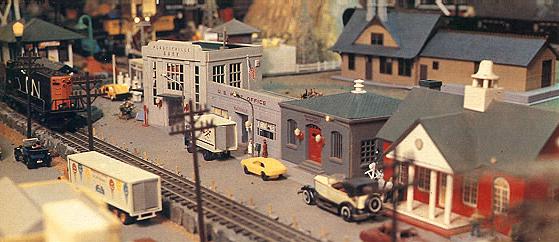
|
[3] A Lionel Canadian National GP-7 approaches the main business
district after crossing the diamond at Genesee Junction. Buildings
(left to right) include the Bank, Post Office, Police Dept. and Town
Hall, with the Fire House (below) just around the corner. |
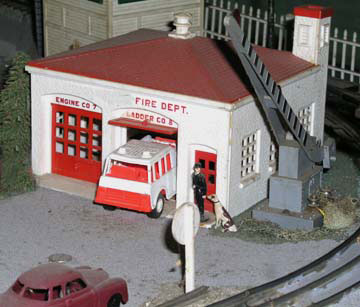
|
|
By 1980, an
estimated 75 to 80 percent of the equipment on the NORMANED
(including trains, structures, track
and accessories) had been restored by the management (over the years) to
useable condition, having been obtained at little or no cost as someone
else's junk or castoffs. Some new equipment was purchased in ensuing years
as the railroad's revenue permitted; however, much if not most of this was
not placed in regular service on the layout but, following a few test runs,
was held in storage as part of the collection for possible future expansion.
(Negotiations for additional space for expansion are frequently
unsuccessful, as is often the case with prototype [“real”] railroads).
Some of the railroad as it now exists was built in sections or
“modules” which, it was intended at the time, might be disassembled and
moved virtually intact if another relocation ever became necessary.
Unfortunately, as the layout grew, more and more track inter-connections
between these sections became desirable, and the electrical wiring became so
complex that an attempt to relocate the entire layout in toto would
probably be futile - although there are several discrete sections which
could be disconnected and salvaged for use on another model railroad in some
other location. |

|
A
string of boxcars rolls by the always-busy Genesee Junction, where the
main line and three branch lines converge for interchange of both
passengers and freight. A close look to the lower right-hand corner of
this view may reward you with a peek at a bathing beauty sitting on
the swimming pool diving board adjacent to the switch tower. |
|
|
As is the
case with most model railroads, the NORMANED
has never been considered “completed,” since “completion” in a hobby
operation would imply, in our opinion, abandonment of the hobby. Although
activity on the railroad has slowed - and for some years nearly stopped
entirely - it has escaped complete abandonment. Visitors to the NORMANED
will be aware of areas unfinished
and/or still under construction, as well as indications of provisions which
have been made for possible future development. Scenery, detailing and
maintenance are always ongoing - only the rate of development may vary from
very little to a lot at any one time.-
|
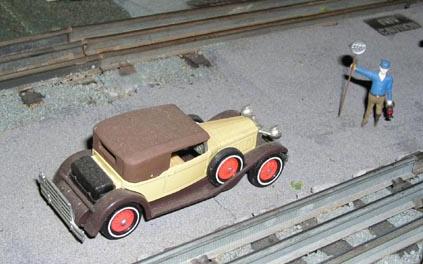
|
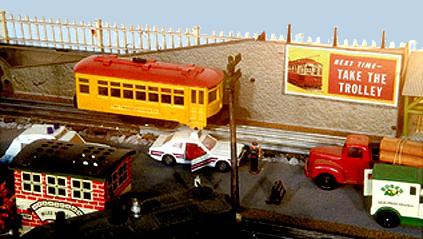
|
|
The NORMANED
utilizes “O” Gauge track (1¼ inches between rails) and is constructed to
one-quarter inch scale (1/48th
actual size). Electrical power for
locomotion (12 to 20 volts AC) is carried through a center third rail in
what is synonymously referred to in the hobby as either Tinplate, Hi-Rail or
Semi-Scale operation. [Later developments of additional scale model train
layouts in both 'N'- and 'HO'-gauge sizes by the “railroad crew” of the NORMANED
are detailed elsewhere in these pages].
= |

|
[ Home ]
|

|
|